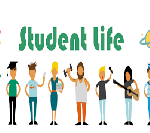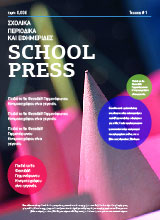By Julia Georgiopoulou
Penguins are a groupof aquatic flightless birds. They live almost exclusively in the Southern Hemisphere. Except for one species, the Galápagos penguin, who is found north of the Equator. Highly adapted for life in the water, penguins have countershaded dark and white plumage and flippers for swimming. Most penguins feed on krill, fish, squid and other forms of sea life which they catch with their bills and swallow it whole while swimming. A penguin has a spiny tongue and powerful jaws to grip slippery prey. They spend roughly half of their lives on land and the other half in the sea.
The largest living species is the emperor penguin on average, adults are about 1.1 m (3 ft 7 inches) tall. The smallest penguin species is the little blue penguin (Eudyptula minor), also known as the fairy penguin, which stands around 30–33 cm (12–13 inches). Today, larger penguins generally inhabit colder regions, and smaller penguins inhabit regions with temperate or tropical climates.

- The emperor penguin is the tallest and heaviest of all living penguin species and is located to Antarctica. The male and female are similar in plumage and size, reaching 100 cm (39 inches) in length and weighing from 22 to 45 kg. Feathers of the head and back are black and sharply definedby the white belly, pale-yellow breast and bright orange ear patches. Like all penguins, it is flightless, with a streamlined body, and wings stiffened and flattened into flippers for a marine habitat. Its diet consists primarily of fish, but also includes crustaceans, such as krill, and cephalopods, such as squid. While hunting, the species can remain submerged around 20 minutes, diving to a depth of 535 m. It has several adaptations to facilitate this, including an unusually structured haemoglobin, whichallows it to function well at low oxygen levels, solid bones help inreducing barotrauma, and the ability to reduce its metabolism and shut down non-essential organ f unctions. The only penguin species that breeds during the Antarctic winter, emperor penguins travel 50–120 km over the ice to breeding colonies which can contain up to several thousand individuals. The female lays a single egg, which is incubated for just over two months by the male while the female returns to the sea to feed. The lifespan is typically 20 years in the wild, although observations suggest that some individuals may live to 50 years of age.

- The little penguin (Eudyptula minor) is a species of penguin from New Zealand. They are commonly known as littleblue penguins or blue penguins owing to their slate-blue plumage. Eudyptula minor breeds along most of the coastline of New Zealand, including the Chatham Islands. They typically grow to between 30 and 33 cm tall and average weigh 1.5 kg. Little penguins feed by hunting small clupeoid fish, cephalopods, and crustaceans, for which they travel and dive quite extensively including to the sea floor. Important little penguin prey items include arrow squid, slender sprat, Graham’s gudgeon, red cod, and ahuru. The average lifetime for the species are 6.5 years, but some studies show that they may live up to 25 years in captivity.
- Behavior
Penguins most of the time breed in large colonies, except the yellow-eyed and Fiordland species. The colonies may range in size from as few as 100 pairs for gentoo penguins to several thousand in the case of king, macaroni and chinstrap penguins. Living in colonies results in a high level of social interaction between birds, which has led to a large repertoire of visual as well as vocal displays in all penguin species. Agonistic displays are those intended to confront or drive off, or alternately appease and avoid conflict with other individuals.
 Penguins create monogamous pairs for a breeding season. Most penguins lay two eggs in a clutch, although the two largest species, the emperor and the king penguins, lay only one. With the exception of the emperor penguin, where the male does it all, all penguins share the incubation duties. These incubation shifts can last days and even weeks as one member of the pair is getting fed at sea. Penguins generally only lay one brood, expect for the little penguin, that can raise two or three broods in a season. Penguin eggs are smaller than any other bird species when compared to the weight of the parent birds, which weights at 52 g, the little penguin egg is 4.7% of its mothers” weight, and the 450 g emperor penguin egg is 2.3%. The relatively thick shell forms between 10 and 16% of the weight of a penguin egg, maybe to reduce the effects of dehydration and to decrease the risk of breakage in an adverse nesting environment. The yolk, too, is large and consists 22–31% of the egg. Some yolk often remains when a chick is born, and is thought to help sustain the chick if the parents are delayed in returning with food.
Penguins create monogamous pairs for a breeding season. Most penguins lay two eggs in a clutch, although the two largest species, the emperor and the king penguins, lay only one. With the exception of the emperor penguin, where the male does it all, all penguins share the incubation duties. These incubation shifts can last days and even weeks as one member of the pair is getting fed at sea. Penguins generally only lay one brood, expect for the little penguin, that can raise two or three broods in a season. Penguin eggs are smaller than any other bird species when compared to the weight of the parent birds, which weights at 52 g, the little penguin egg is 4.7% of its mothers” weight, and the 450 g emperor penguin egg is 2.3%. The relatively thick shell forms between 10 and 16% of the weight of a penguin egg, maybe to reduce the effects of dehydration and to decrease the risk of breakage in an adverse nesting environment. The yolk, too, is large and consists 22–31% of the egg. Some yolk often remains when a chick is born, and is thought to help sustain the chick if the parents are delayed in returning with food.
When emperor penguin mothers lose a chick, they sometimes attempt to «steal» another mother’s chick, usually unsuccessfully as other females in the vicinity assist the defending mother in keeping her baby. In some species, such as emperor and king penguins, the chicks assemble in large groups called crèches.

- Penguins and humans
Penguins have no special fear of humans and will often approach them. This is probably because penguins have no land predators in Antarctica or the nearby islands. They are preyed upon by other birds like skuas, petrels, sheathbills, and gulls especially in eggs and as fledglings. Dogs preyed upon penguins while they were allowed in Antarctica during the age of early human exploration as sled dogs, but dogs have been banned from A ntarctica a long tune ago. Instead, adult penguins are at risk at sea from predators such as sharks, orcas, and leopard seals. Typically, penguins do not approach closer than around 9 feet (3 meters), at which point they appear to become nervous..

- Movies, video games, comics etc dedicated to and inspirated by penguins
Penguins have been the subject of many books and films, such as Happy Feet, Surf’s Up and Penguins of Madagascar, March of the Penguins, a documentary based on the migration process of the emperor penguin and Mr. Popper’s Penguins, the children’s book written by Richard and Florence Atwate and a great movie of success later. Penguins have also appeared in a number of cartoons and television dramas, including Pingu.
A video game called Pengo was released by Sega in 1982. Set in Antarctica, the player controls a penguin character who must navigate mazes of ice cubes. The player is rewarded with cut-scenes of animated penguins marching, dancing, saluting and playing peekaboo. Moreover, penguins are also sometimes even depicted in music.
In 1941, DC Comics introduced the avian-themed character of the Penguin as a supervillain adversary of the superhero Batman. He became one of the most enduring enemies in Batman’s rogues gallery. In the 60s Batman TV series,played by Burgess Meredith, he was one of the most popular character, and in Tim Burton’s reimagining of the character in the 1992 film Batman Returns, he employed an actual army of penguins.
Source of information: https://en.m.wikipedia.org/wiki/Main_Page

















